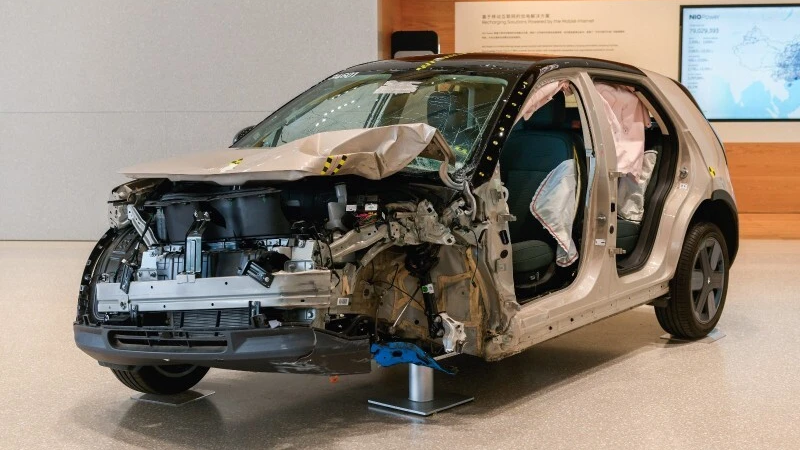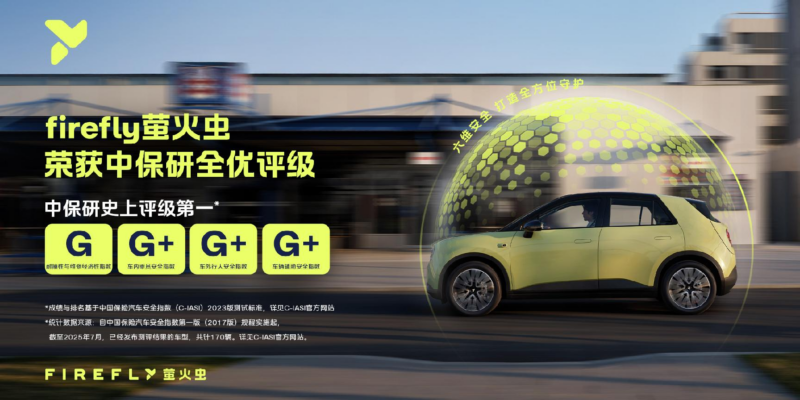The Firefly, a compact vehicle by Nio, has become the first small car to achieve an “all-good” rating across all four assessment categories in the latest China Insurance Automotive Safety Index (C-IASI) official test results.
The Firefly received the highest “G+” (Good+) rating for Occupant Safety Index, Pedestrian Safety Index (Outside the Vehicle), and Vehicle Auxiliary Safety Index. Its “Crashworthiness & Maintenance Economy Index” also achieved a “Good” (G) rating. This places the Firefly alongside the Aito M9 and Onvo L60 as only the third models in C-IASI history to achieve “Good” or “Good+” (G and G+) ratings across all four categories.
The Occupant Safety Index resulted in the Firefly achieving “Good” ratings in all eight sub-items. In the Pedestrian Safety Index, the Firefly scored full marks in the AEB pedestrian protection test. For the Vehicle Auxiliary Safety Index, the Emergency Call (E-call) service, Lane Keeping Assist System, and Driver Monitoring System (DMS) all received perfect scores, contributing to an overall score rate of 94.7%. In the Crashworthiness & Maintenance Economy Index, where 5.4% of vehicles achieve a “Good” rating, the Firefly outperformed models priced above 200,000 yuan (28,000 USD).

Since the implementation of the C-IASI in 2018, Firefly is the first compact car to achieve such safety results. The Firefly’s body length of 4,003 mm is the smallest among the 161 models tested by C-IASI in its history. The average length of the tested vehicles is 4,807 mm, and other models that have achieved “all-G” ratings are all longer than 4,500 mm.

About C-IASI
The China Insurance Automotive Safety Index (C-IASI) is a vehicle collision safety performance evaluation system in mainland China. Established by the CIRI Auto Technology Institute (CIRI), C-IASI is funded by Chinese insurance companies, similar to the American IIHS. Its direct link to insurance claims contributes to its reputation for strictness and credibility.
The four levels of C-IASI are G (Good), A (Acceptable), M (Marginal) and P (Poor). This year, C-IASI introduced stricter regulations, including a new “G+” (Good+) rating that requires all sub-items to achieve a “G” rating. New tests include a passenger-side frontal 25% offset collision and a frontal 50% offset collision. The side impact barrier mass has also been increased from 1500kg to 1650kg, with greater rigidity and a higher impact position.
Detailed test performance of the Firefly:
- Frontal 25% offset collision (64.4 km/h): The Firefly achieved a “G” rating. This challenging test simulates a vehicle losing control and colliding with a guardrail or an oncoming vehicle.
- Frontal 50% offset collision (50 km/h): The Firefly received a “G” rating. In this test, 50% of the vehicle overlaps with the barrier, concentrating collision energy and demanding high structural strength and energy absorption.
- Side impact collision (50 km/h): The Firefly achieved a “G” rating. This test simulates a high-speed side impact from a large SUV, common in intersection accidents.
- Pedestrian safety index (outside the vehicle): The Firefly earned a “G+” rating. This test simulates low-speed collisions with pedestrians or electric vehicles, focusing on protecting pedestrian legs and minimising injuries.
- Auxiliary safety index: The Firefly achieved a “G+” rating. This test assesses the vehicle’s ability to automatically initiate braking to avoid or mitigate collisions when potential hazards are detected.
- Crashworthiness & maintenance economy index: The Firefly received a “G” rating. This test evaluates the convenience and cost-effectiveness of repairs after minor low-speed collisions, aiming to minimise damage to high-value components.



